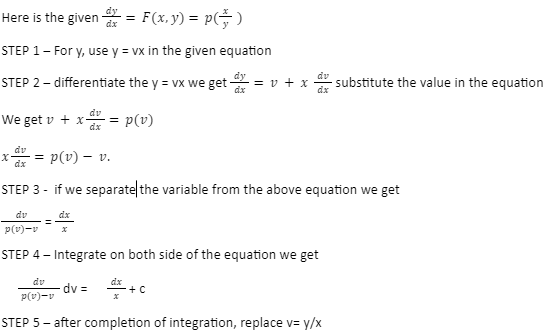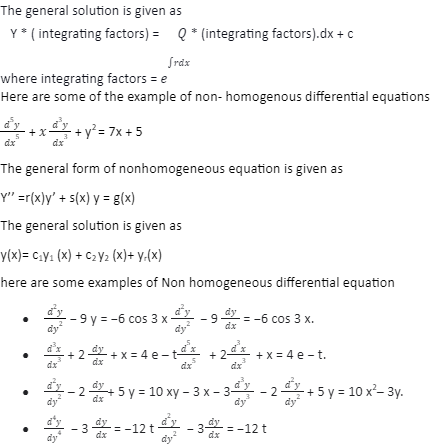In this article students will be made familiar with the concept of solving homogenous differential equations in a precise and concise manner to help them prepare for CBSE classes 11th and 12th examinations. The aim of the article is to help students grasp the concepts easily through an easy-to-understand and well-written study guide. ODE, commonly known as ordinary differential equations, are differential equations where only one variable is present. But it has lots of derivatives concerning variables. Example: (d2y / dx2) + (dy / dx) = 3y tan (x).
The ordinary differential equation is further classified into two. They are –
- Homogeneous differential equation
- Non-homogenous differential equation
An Overview on SOLVING HOMOGENEOUS DIFFERENTIAL EQUATIONS
- The equation that contains differentiation, set of variables, and functions of (x, y) is called a homogenous differential equation.
- The homogenous function in the homogenous differential equation is f (x, y), if
f (δx,δy) = δ n f(x,y) where δ is non zero constant
- The general form of the homogenous differential equation is as below
f(x,y).dy + g(x,y).dx = 0
- The homogenous differential equation should have the same power for the given variables (x, y)
Homogenous differential equation
f(x,y).dy + g(x,y).dx = 0
dx/dy = F(x,y)
Homogenous function
f (δx,δy) = δ n f(x,y)
where δ is non zero constant.
- no constant term is present in the homogenous differential equation; only in the linear differential equation, and you can see the constant term
- If we remove the constant term from the linear differential equation, then the equation would turn into the homogenous differential equation
- No variable is present in the special functions like logarithm of trigonometric
WHAT ARE DIFFERENTIAL EQUATIONS?
- If the equation has one unknown derivate is called a differential equation. It may be either a partial equation or an ordinary equation.
- Suppose if the rate of change of function q concerning p is inversely proportional to q, we express it as
dq/dp = k/q
- In calculus, In the differential equation, both deviates of the dependent and independent variables are involved.
- The differential equation represents nothing but the change of something concerning something and the relationship between them.
- For example, Q=F(p), where,
Q – dependent variable
p is the independent variable
F is an unknown function
Below are a few differential equations examples for a clear understanding.
HOMOGENOUS DIFFERENTIAL EQUATION EXAMPLE
Here are some examples
- dy/dx = (6x + y)/(10x – y)
- dy/dx = x(5x -12y)/y2
- dy/dx = (2×2 + 5y2)/xy
- dy/dx = (3x + 9y)/(x – 2y)
- dy/dx = (11×3 + y3)/(5xy2 + 6yx2)
You can substitute x and y in all the above examples to prove the homogenous differential equation.
- x = δx
- y = δy
Substitute x/y = v or x= vy when the Homogenous differential equation is in the form of dx/dy=f(x,y) and have the homogenous function f(x,y).
Then carry the integration part and substitute the values in the variable x,y to solve the homogenous differential equation.
Here is one of the examples for a clear understanding
HOMOGENOUS DIFFERENTIAL EQUATION SOLVER
We provided some of the easy steps to solve homogeneous differential equations.

NON- HOMOGENOUS DIFFERENTIAL EQUATION SOLVER
- It is much similar to that of a linear equation, and the order of the differential equation is not similar.
- For example
- The differential equation of the form
(dy/dx) + Ry = S where R, S are the constant or the function of y

Conclusion
Through this precise and concisely written article, students have been made familiar with the concept of solving homogenous differential equations in a precise and concise manner to help them prepare for CBSE classes 11th and 12th examinations. The article has helped the students grasp the concepts of – solving homogenous differential equations, homogeneous differential equation example, homogeneous and non-homogeneous differential equation solver in an easy-to-understand and well-written manner.
 Profile
Profile Settings
Settings Refer your friends
Refer your friends Sign out
Sign out






